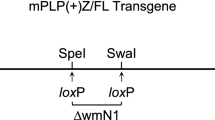Abstract
MAJOR histocompatibility complex (MHC) molecules are not normally expressed in the central nervous system (CNS)1–3. However, aberrant expression has been observed in multiple sclerosis lesions and could contribute to the destruction of myelin or the myelinating cells known as oligodendrocytes4,5. The mechanism of cell damage associated with aberrant MHC molecule expression is unclear: for example, overexpression of class I (ref. 6) and class II (refs 7, 8) MHC molecules in pancreatic β cells in transgenic mice leads to nonimmune destruction of the cells and insulin-dependent diabetes mellitus. We have generated transgenic mice that express class I H–2Kb MHC molecules, under the control of the myelin basic protein promoter, specifically in oligodendrocytes. Homozygous transgenic mice have a shivering phenotype, develop tonic seizures and die at 15–22 days. This phenotype, which we term 'wonky', is due to hypomyelination in the CNS, and not to involvement of the immune system. The primary defect appears to be a shortage of myelinating oligodendrocytes resulting from overexpression of the class I MHC molecules.
Similar content being viewed by others
References
Wong, G. H. W., Bartlett, P. F., Clark-Lewis, I., Battye, F. & Schrader, J. W. Nature 310 688–691 (1984).
Bartlett, P. F., Kerr, R. S. C. & Bailey, K. A. Transpl. Proc. 21, 3166–3168 (1989).
Traugott, U. J. Neuroimmun. 16, 283–302 (1987).
Bartlett, P. F. & Mackay, I. R. J. clin. Lab. Immun. 11, 1–7 (1983).
McFarlin, D. E. & McFarland, H. F. New Engl. J. Med. 307, 1183–1188 (1982).
Allison, J. et al. Nature 333, 529–533 (1988).
Sarvetnick, N., Liggitt, D., Pitts, S. L., Hansen, S. E. & Stewart, T. A. Cell 52, 773–782 (1988).
Lo, D. et al. Cell 53, 159–168 (1988).
Okano, H. et al. EMBO J. 7, 77–83 (1988).
Tamura, T., Miura, M., Ikenaka, K. & Mikoshiba, K. Nucleic Acids Res. 16, 11441–11459 (1988).
Morahan, G., Allison, J. & Miller, J. F. A. P. Nature 339, 622–624 (1989).
Morahan, G. et al. Proc. natn. Acad. Sci. U.S.A. 86, 3782–3786 (1989).
Murphy, K. M., Weaver, C. T., Elish, M., Allen, P. M. & Loh, D. Y. Proc. natn. Acad. Sci. U.S.A. 86, 10034–10038 (1989).
Jones-Youngblood, S. L., Wieties, K., Forman, J. & Hammer, R. E. J. Immun. 144, 1187–1195 (1990).
Miller, J., Daltch, L., Rath, S. & Selsink, E. J. Immun. 144, 334–341 (1990)
Gilfillan, S., Aiso, S., Michie, S. A. & McDevitt, H. O. Proc. natn. Acad. Sci. U.S.A. 87, 7319–7323 (1990).
Kidd, G. J., Hauer, P. E. & Trapp, B. D. J. Neurosci. Res. 26, 409–418 (1990).
Mitchell, L. S. et al. J. Neurosci. Res. 27, 125–135 (1990).
Panitch, H. S., Hirsch, R. L., Haley, A. S. & Johnson, K. P. Lancet i, 893–895 (1987).
Gould, R. M. J. Cell Biol. 75, 326–338 (1977).
Perier, O. & Gregoire, A. Brain 88, 937–956 (1965).
Sternberger, L. A. in Immunocytochemistry 2nd edn (Wiley, New York, 1979).
Kerlero De Rosbo, N., Carnegie, P. R., Bernard, C. C. A. & Lunthicum, D. S. Neurochem. Res. 9, 1359–1369 (1984).
Schen, H. Z., Turnley, A., Murphy, M., Bernard, C. C. A. & Bartlett, P. F. J. Neurosci. Res. 23, 425–432 (1989).
Ranscht, B., Clapshaw, P. A., Price, J., Noble, M. & Seifert, W. Proc. natn. Acad. Sci. U.S.A. 79, 2709–2703 (1982).
Smith, M. H., Parker, J. M. R., Hodges, R. S. & Barber, B. H. Molec. Immun. 23, 1077–1092 (1986).
Author information
Authors and Affiliations
Rights and permissions
About this article
Cite this article
Turnley, A., Morahan, G., Okano, H. et al. Dysmyelination in transgenic mice resulting from expression of class I histocompatibility molecules in oligodendrocytes. Nature 353, 566–569 (1991). https://doi.org/10.1038/353566a0
Received:
Accepted:
Issue Date:
DOI: https://doi.org/10.1038/353566a0
- Springer Nature Limited
This article is cited by
-
Corticohippocampal Dysfunction In The OBiden Mouse Model Of Primary Oligodendrogliopathy
Scientific Reports (2018)
-
Role of non-immune mechanisms of muscle damage in idiopathic inflammatory myopathies
Arthritis Research & Therapy (2012)
-
Transgenic mouse models of multiple sclerosis
Cellular and Molecular Life Sciences (2010)
-
Defective MHC class I antigen surface expression promotes cellular survival through elevated ER stress and modulation of p53 function
Cell Death & Differentiation (2008)
-
Pathogenesis of idiopathic inflammatory myopathies
Current Rheumatology Reports (2006)





